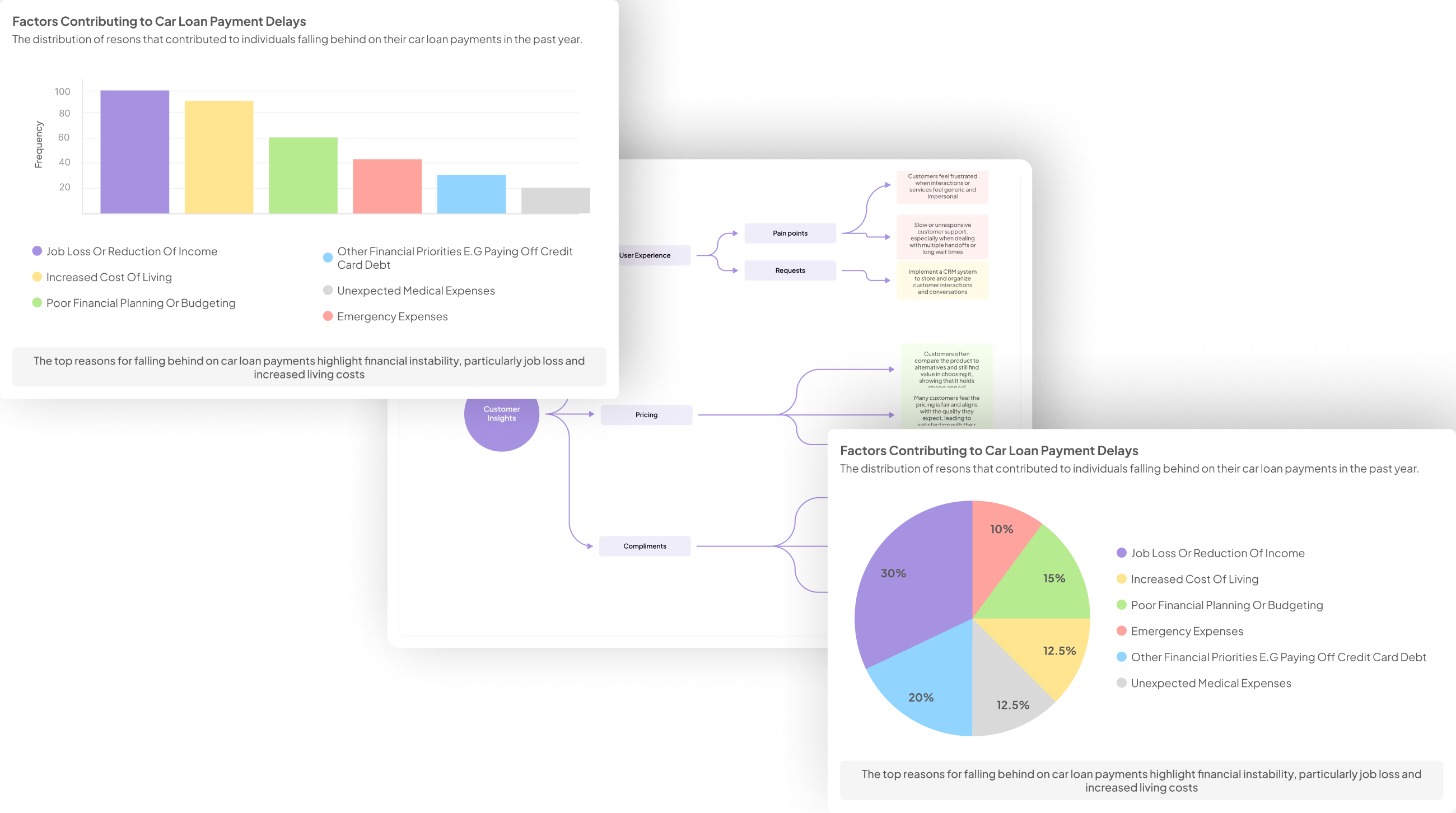Speech Analytics for Collections: Actionable Tips
-
Bella Williams
- 10 min read
In the world of collections, effective communication can make or break a deal. Collections Speech Analytics provides insights into customer interactions that help organizations refine their strategies and improve outcomes. By analyzing recorded conversations at scale, teams can identify patterns and pain points that directly impact collections success.
This introduction aims to shed light on how Collections Speech Analytics transforms routine calls into valuable data. With the ability to transcribe and analyze interactions swiftly, organizations can uncover actionable insights that drive better engagement with customers. Understanding these analytics empowers collections teams to enhance their approach and foster stronger relationships with clients.
Generate visualizations from your qualitative data. At Scale.

Enhancing Collections Strategies with Speech Analytics
Utilizing Collections Speech Analytics can transform your collections strategies by providing crucial insights through voice data analysis. By examining the interactions between agents and customers, organizations can identify common pain points and determine the most effective communication styles. This analytical approach not only highlights areas of improvement but also underscores successful tactics that resonate with consumers, ultimately enhancing overall performance.
A focused implementation of speech analytics should involve careful consideration of certain aspects. Firstly, it’s essential to gather and analyze historical call data to recognize trends and behavioral patterns. Secondly, defining clear objectives can guide the analytics process and ensure alignment with strategic goals. Lastly, continual training based on insights garnered from speech analytics can empower collections teams to engage customers more effectively. By employing these methods, you can significantly improve collection rates and foster positive relationships with clients.
Identifying Key Behavioral Patterns in Collections Calls
Understanding key behavioral patterns in collections calls is essential for enhancing overall efficiency and effectiveness. By utilizing Collections Speech Analytics, teams can systematically analyze conversations to identify trends and common triggers that drive customer responses. Listening to how representatives engage with customers helps to highlight effective strategies and areas needing improvement.
A deep dive into these conversations can reveal the tone, pacing, and language that resonate most with customers. This process often uncovers insights into customer sentiment, which can then be used to refine training programs and boost agent performance. By focusing on specific patterns, collections teams can transform their operations, leading to improved interactions and increased recovery rates. In summary, tracking behavioral patterns through meticulous analysis paves the way for ongoing refinements in collections strategies.
Leveraging Real-Time Speech Analytics for Improved Outcomes
Real-time speech analytics plays a crucial role in improving outcomes for collections teams. By analyzing conversations as they happen, teams can quickly adapt their strategies to better meet customer needs. This immediate access to insights allows collectors to transition from a transactional approach to a more consultative style. The ability to assess call quality in real time can lead to enhanced coaching and training opportunities, ultimately improving the effectiveness of collections efforts.
To effectively utilize collections speech analytics, consider the following steps:
Monitor Customer Sentiment: Gauge customer emotions during calls to tailor your responses and improve engagement.
Identify Common Questions: Recognize frequently asked questions to streamline training materials and FAQs for your team.
Provide Immediate Feedback: Offer constructive feedback to staff instantly, helping them refine their approach and improve customer interactions.
By implementing these strategies, teams can create a more positive experience for both collectors and customers, resulting in improved performance and stronger relationships.
Evaluate Performance on Customer Calls for Quality Assurance.
Actionable Tips for Implementing Collections Speech Analytics
To effectively implement Collections Speech Analytics, begin with setting clear objectives and success metrics. Understanding your goals helps create a focused approach, ensuring yield from your speech analytics investments. Define specific KPIs around customer interactions, such as resolution rates or customer satisfaction scores. These metrics will guide your analysis and help assess performance accurately.
Next, integrate speech analytics with existing systems. This involves ensuring compatibility with your current customer relationship management (CRM) and collections platforms. Seamless integration enhances data utilization, allowing teams to leverage insights directly within their workflows. Once integrated, prioritize training and equipping your collections teams on how to use the technology effectively. Training fosters confidence and encourages staff to utilize analytics insights while engaging with customers. Together, these steps create a robust framework for implementing Collections Speech Analytics, driving better engagement strategies and positive outcomes.
Step 1: Setting Clear Objectives and Success Metrics
Setting clear objectives is crucial in effectively utilizing collections speech analytics. First, define what you aim to achieve by implementing this technology. Objectives could range from improving call opening techniques to enhancing issue resolution strategies. By determining these goals, you create a focused approach that guides your analysis and actions.
Next, establish success metrics that allow you to measure progress. These metrics might include call engagement scores, resolution rates, or customer satisfaction statistics. Regularly assessing these indicators provides actionable insights, enabling you to refine your tactics. This continuous improvement cycle fosters a clearer understanding of how collections speech analytics impact your overall performance and contributes to achieving desired outcomes.
Step 2: Integrating Speech Analytics with Existing Systems
Integrating speech analytics with existing systems is essential for optimizing collections efforts. Start by evaluating your current systems and identifying the points where speech analytics can enhance functionality. Collaboration among departments facilitates seamless integration, allowing for insights gained from collections speech analytics to be shared across your organization. This promotes a unified approach to handling debt-related conversations and enhances the overall customer experience.
Next, ensure that your data management processes can accommodate the volume of insights generated. Efficient data pipelines should automate the transcription and analysis of calls, leading to quicker, more accurate insights. By integrating these analytical capabilities with your customer relationship management (CRM) system, you leverage a comprehensive view of customer interactions. Ultimately, this integration tackles pain points identified in collections calls, driving better outcomes and maximizing collection efficiency.
Step 3: Training and Equipping Collections Teams
Training and equipping collections teams is vital for maximizing the effectiveness of Collections Speech Analytics. Empowering team members with comprehensive training ensures they are well-versed in the technology and its applications. Starting with an overview of speech analytics, teams should learn how to interpret data and utilize insights gathered from calls to enhance customer interactions.
Next, equipping teams with ongoing support through role-playing and real-time feedback mechanisms can further boost their confidence and performance. Incorporating scenario-based training helps employees practice strategies in handling different types of customer objections and questions. Importantly, fostering an environment of continuous learning and feedback allows teams to adapt and improve based on their experiences. This holistic approach not only strengthens the team's skills but also optimizes the usage of analytics tools, leading to better collection rates and customer satisfaction.
Conclusion: Maximizing Success with Collections Speech Analytics
To maximize success with Collections Speech Analytics, it is essential to focus on the insights derived from your data. By effectively analyzing call interactions, organizations can uncover actionable patterns that drive improved collection strategies. These analytics empower teams to understand customer sentiments, identify roadblocks, and develop tailored solutions addressing client needs.
Implementing these insights requires consistent monitoring and adaptation. Regularly reviewing data not only enhances collection tactics but also fosters a culture of continuous improvement. Utilizing Collections Speech Analytics can significantly boost recovery rates and enhance overall customer relationships, ultimately leading to more productive engagements and lasting success in collections efforts.







